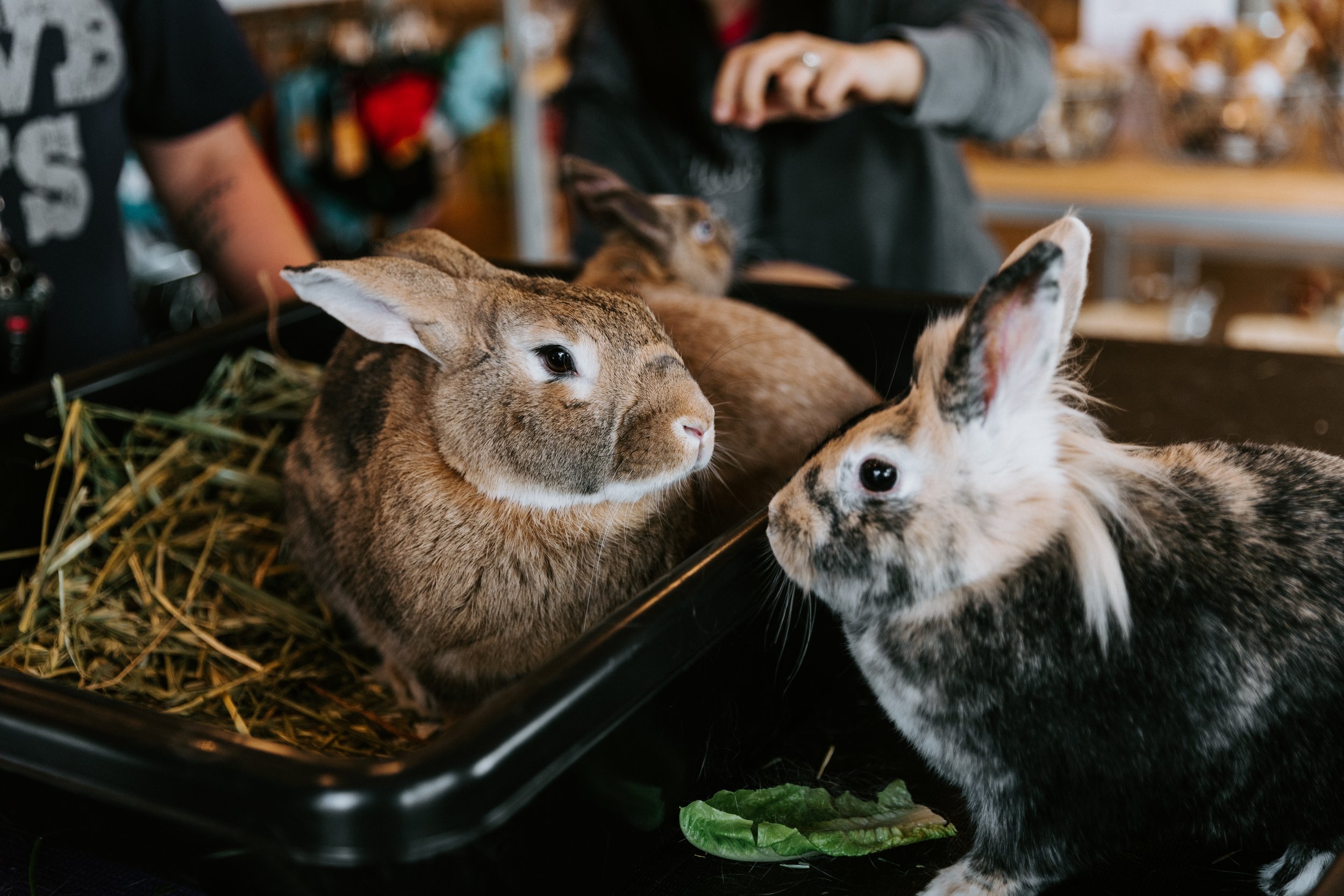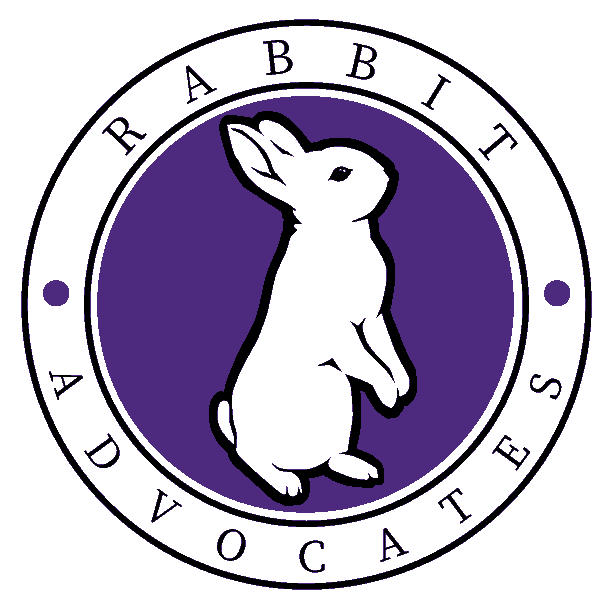
Litter Training
One of the #1 things that surprises many people about bunnies is that they can be litter trained. It is much easier to litter train a spayed/neutered bunny.
With the right parameters in place, bunnies are pretty easy to litter train. If you set up the right environment in an indoor home setting, bunnies will often train themselves because bunnies prefer to be clean. Bunnies do like to eat hay and go potty at the same time, so they need plenty of space to keep both areas separate within the litter box. They also need help from humans to keep their litter box nice and clean. As you get to know your rabbit(s), you will learn more about their unique potty preferences and behaviors.
It is easier to litter train a spayed/neutered bunny. This is one of the many reasons why Rabbit Advocates only adopts out bunnies who are already spayed and neutered. Try to aim for at least 85% of poo and 99% of pee to go in the litter box after a bunny is spayed/neutered and has the right setup in place.
No cages. Although restricting a bunny’s space to an exercise pen can be helpful for litter training, actual cages sold at pet stores are detrimental to litter training. Bunnies do not like the small corner litter boxes often found in cages because they cannot fit in them, just like a human child could not go potty in a dollhouse toilet.
Check to be sure the bunny is on the right diet for their age and health status. A diet too high in sugar (for example from fruit or carrots), too high in calcium (often from alfalfa or greens like kale/spinach), or too rich (typically from too many pellets or treats and not enough hay), bunnies may start to leave their cecotropes behind and/or urinate outside the litter box.
Check to be sure your bunny likes the type of litter bedding you’re using. Some bunnies have preferences and may prefer one over the other. There are lots of safe options to try.
Already litter trained bunnies may need extra help while transitioning from one house to another. For example, when rabbit(s) transition from their foster to adoptive home, or if their adopters move to a new house, it’s a good idea to gradually increase their access to more parts of the home to help with transitional litter training. Especially if there are other pets or pet smells in the new space, this can amplify territorial behaviors in rabbits who are trying to establish their new turf. This is also true when pet sitting because bunnies are adjusting to a new situation. If taken outdoors, rabbits will often engage in territorial behaviors due to all the smells outside. All of these tips will help to reestablish good habits.
You may need to consult a veterinarian. If bunny who has been previously litter trained starts to have issues with incontinence or “accidents”, it is helpful to see a bunny-savvy veterinarian. This is particularly true if the bunny has not recently moved to a new home, has not had to acclimate to a new bunny or other pet(s) in the household, or has not had to adjust to other household changes like renovations or a new child. There could be hind end mobility issues associated with the spine or hips, bladder issues, GI problems related to infection or parasites, or other medical reasons why their litter training has regressed.
Here are some ideas to try!
First and foremost, spay and neuter all rabbits. If the bunny is not yet fixed or just getting fixed, then wait about 2 weeks after spay/neuter once they've healed and hormone levels come down. Some bunnies are messier in the week after spay/neuter due to “hormone surges” that are a normal part of the healing process. Litter training should get better once their hormone levels are lower. Note that bunnies who are 4+ years old at the time of spay/neuter may need extra time for their hormones to decline.
Keep rabbit(s) in an exercise pen to temporarily limit their space, or use baby gate(s) to keep rabbit(s) in one room. It’s acceptable to limit bunnies’ access to parts of the house during litter training and transitional periods, but bunnies must still have room to move around at all times to keep them fit, healthy, and eating/digesting properly. During litter training, it may be necessary to keep 1 bunny under ~5 lbs in 16-20 sq ft of space on one level, or 2 small bunnies in about 25 sq ft of space on one level. Larger bunnies will need more space. Multi-level condos and hutches are only okay if they’re in addition to the 16-20++ sq ft of space on one level. Cages are harmful and confining bunnies to too small a space can backfire because bunnies are miserable in cages and can develop cage aggression and/or become withdrawn. However, using the entire bottom part of an old cage as one big litter box is one way to repurpose it.
Giant litter boxes and heaps of hay. Cement mixing tubs from home stores and under-bed storage bins are great. Bigger bunnies and bonded pairs definitely need more space, too. Most cat litter boxes are too small and when bunnies lift their tails to urinate, the urine will shoot over the low edge of the too-small litter box. The bunny is trying to do the right thing, and just needs the right setup.
Multiple litter boxes and one with no hay or food in it, only bedding. The extra litter box(es) with no hay can be next to other litter boxes with hay access. Having one or more litter boxes without food in them is helpful for bunnies who have experienced food insecurity in the past. One method is to cover almost the entire floor of the exercise pen with various litter boxes, except for maybe the water bowl area, and then gradually remove litter boxes as the bunny demonstrates their ability to use the litter boxes.
Keep litter box(es) clean with daily spot cleaning and regular full cleaning. If the litter box is dirty, the bunnies may not want to go in it.
Serve all food in/next to the litter box. Those cute bunny butts need to be over a litter box to eat anything. Put hay into a rack and/or far enough away from the floor so that the bunnies have to be inside the box to reach the food. Move their pellet dish into one of the giant litter boxes so they have to eat all their food in the litter box. Bums in boxes!
New bunny blankets, toys, and hidey houses may help because they do not have all the smells of other bunnies/pets. That said, some bunnies will still feel compelled to mark their scent and claim new items with their own pee/poo, hopefully just temporarily. If the bunny leaves just 1-3 poops somewhere, it is definitely a territorial marker, just like astronauts putting down a flag when they land on the moon. A couple poops indicate “I was here” and “Mine!”
Some bunnies find certain surfaces or a particular place in the house to be irresistible and they feel a need to pee on them. Towels and corners seem to common faves. One noteworthy exception is human beds and sofas. Bunnies might pee on your bed or couch as a way to claim you as their own, since any place that smells of their favorite humans is a place bunnies often like to be. It’s actually a bunny’s compliment to their humans, although it certainly doesn’t feel that way when you’re washing your sheets (again). Covering trouble spots with furniture or a blanket can help.
For babies, sometimes puppy pads and/or lots of layered, washable blankets on the floor will save your sanity. The babies may shred them but as long as they're not eating the bits or making too much puppy pad "confetti", it is easier/faster to clean up and keeps the babies from getting urine on their feet.
When bonding two bunnies together, first be sure that both are spayed/neutered and check out RA’s bonding guide. During the bonding process, it is normal to experience a resurgence of messy litter behaviors during the first few months due to territorial impulses and a desire to “show off” for one another. The new pair’s litter behaviors should improve within 3-4 months after being bonded. Following all these tips to reestablish good habits will help.
If problems persist even after spay/neuter and after consulting a vet, keep in mind that litter training problems may be the result of previous neglect that the bunnies have experienced. Many rabbits were in tiny cages with no real litter boxes, left out in the woods or in a park, or stuck in a filthy environment. It’s possible they never had a proper space and a litter box until now. The bunnies may have learned that if they urinate or defecate near food sources, they may go hungry since no one gave them fresh hay and clean litter bedding regularly. Issues could also be related to deliberate genetic inbreeding in bunnies that is common practice among purebred breeders or “backyard breeders”. The supportive methods listed above help to reverse the undesirable behaviors the rabbits were forced to practice due to neglect/abandonment/trauma and/or multi-generational inbreeding. It can take rabbit(s) some time in a safe, loving environment to get their litter training to a better place.
Sources:
Special Bunny. https://www.specialbunny.org/litter-training/
House Rabbit Society. https://rabbit.org/care/litter-training/
Rabbit Haven. https://www.rabbithaven.org/litterbox-training
101 Rabbits. https://youtu.be/E3Es_4hWsCI
